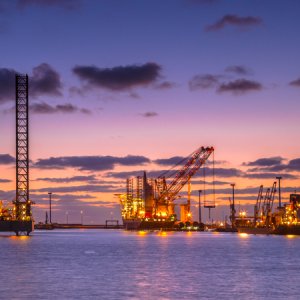Operational Targets of Mexico’s Energy Policy

STORY INLINE POST
Q: What are the production targets for Mexico in the coming years, and what roles will PEMEX and the private sector play in achieving these targets?
A: The Energy Reform will allow our country to increase oil production from 2.5 million b/d in 2014 to 3 million b/d by 2018, and to 3.5 million b/d by 2025, considering both PEMEX and the private sector. For natural gas, we expect production to increase from 5,700mcf/d to 8,000mcf/d by 2018, and to 10,400mcf/d by 2025. In order to achieve these goals, the Energy Reform eliminates current restrictions on the private sector’s participation in the oil and gas value chain, based on a flexible contracting framework founded on standard models that are well-known in the industry. Under this legal framework, the Mexican government will be able to award license contracts, profit-sharing contracts, production-sharing contracts, and service contracts for oil and gas exploration and production activities to both national and international companies. Furthermore, the government will be able to grant permits for refining, as well as for the storage and transportation of hydrocarbons and petrochemicals. These changes will attract significant new investments while relieving PEMEX from the obligation of developing the entire hydrocarbons value chain on its own.
Q: Which role should SENER play in improving Mexico’s 1P, 2P and 3P reserves replacement rate, and how could energy policy targets be transformed into the incorporation of actual reserves?
A: Mexico has a wide range of hydrocarbon resources and reservoirs with very different characteristics. The appropriate exploration and production of these resources requires both conventional and unconventional processes, although the latter are usually associated with higher risk. In this regard, one of the main objectives of the Energy Reform is the introduction of flexible contracting models for exploration and production that can be adapted to the particular characteristics of each oilfield. These contracts will take into consideration the geology, technical difficulties, and levels of risk of each project or field. SENER will define the most convenient contractual terms to achieve a rational reserves replacement rate of around 100%. SHCP will design fiscal terms for each field in order to maximize the oil and gas revenues for Mexico.
Both ministries will work together to present a contractual scheme that is both attractive to the private sector in terms of profitability, and to the government in terms of reserves incorporation, recovery factor and sustainable production. The role of SENER, as head of the national energy sector, is to guarantee energy security for Mexico, by defining its energy policy as well as managing the country´s oil and gas reserves. Once the secondary laws have been approved by Congress, SENER´s responsibilities will include fostering and promoting investments in exploration and production through open international bidding rounds, which will lead to an increase of 1P, 2P and 3P reserves and their respective replacement rates, allocating oil entitlements, and selecting the areas that may be subjected to contracts through a bidding process. With the participation of the private sector, hydrocarbon exploration and production investments and activities will multiply. Therefore, both oil and gas reserves and the restitution rate will increase.
Q: What implications does the Energy Reform have on the role of SENER in the Mexican oil and gas industry, and the cooperation between SENER, SHCP, CNH and PEMEX?
A: SENER will continue to be the authority responsible for defining energy policy. It will award oil entitlements to PEMEX, as well as decide on the areas that will be subjected to hydrocarbon exploration and production contracts. Additionally, SENER will design the contracts and technical rules for tenders and grant permits for oil refining and gas processing activities. The Energy Reform establishes a tight cooperation among authorities to ensure efficiency and transparency. For instance, whereas SENER and SHCP will define the contractual and fiscal terms in consultation with each other, CNH will provide technical assistance to both, as well as manage and supervise the fulfillment of the contracts. International experience demonstrates, in regulatory terms, that there must be a clear division of tasks and responsibilities in order to improve the state’s capabilities in this regard. The model is based on counterweights between the different authorities, so that a balanced and transparent solution is achieved. The Energy Reform prioritizes the nation’s interests by maximizing oil revenues as the result of orderly cooperation between SENER, SHCP, CNH, and PEMEX.
Q: What are the main trade-offs in the entitlements given to PEMEX during Round Zero?
A: Round Zero was a crucial step to allow PEMEX to transform into a state-owned productive enterprise, granting it with the necessary resources to guarantee production levels and appropriate reserve replacement rates. During this process, PEMEX was allowed a first mover advantage by requesting upstream projects before these were offered to other market participants through bidding rounds. It is important to point out that PEMEX will only be entitled to those projects in which it can demonstrate enough financial and technical capacity to produce oil and gas efficiently on its own. This will reduce any trade-offs that PEMEX’s transformation might present. It is worth noting that after Round Zero, the state will be able to allocate projects through different tenders in which PEMEX may participate alone or through partnerships with other companies as long as it can also demonstrate the necessary technological, financial, and human resources capabilities. Otherwise, the projects will be awarded to the company best suited for each task.
Q: How will SENER ensure that the participating companies in bidding rounds have the necessary technological capabilities, experience, and financial strength?
A: Once the secondary laws have been approved, SENER will define the contractual terms based on international best practices in the oil and gas industry. Additionally, SENER will issue the technical guidelines for the bidding process. These guidelines, rules, and contracts will set minimum requirements, known as prequalification requirements, which must be complied with by interested parties. These will guarantee that the companies wishing to bid can meet the right operational, industrial, and environmental safety requirements, and account for their financial and technological capabilities, as well as the expertise necessary for hydrocarbon exploration and production activities. SENER will count on the technical assistance of CNH to design the tender guidelines as CNH will be in charge of ensuring that participating companies qualify. Furthermore, fiscal terms may include a signature bonus indicative of the offering party’s trustworthiness. The signature bonus will increase the cost of entry, and prevent speculation, as well as provide a minor financial incentive to seek early production in order to recover the investment.
Q: What are the most important priorities and objectives for SENER in the next 12 months?
A: SENER’s main objectives are the implementation of the secondary laws once approved by Congress, defining the exploration areas and fields that PEMEX will keep as a result of Round Zero before September 17, 2014, designing the contractual terms and selecting areas for the first bidding round, publishing the first bidding round, and awarding the fields and areas before the end of 2015.





















